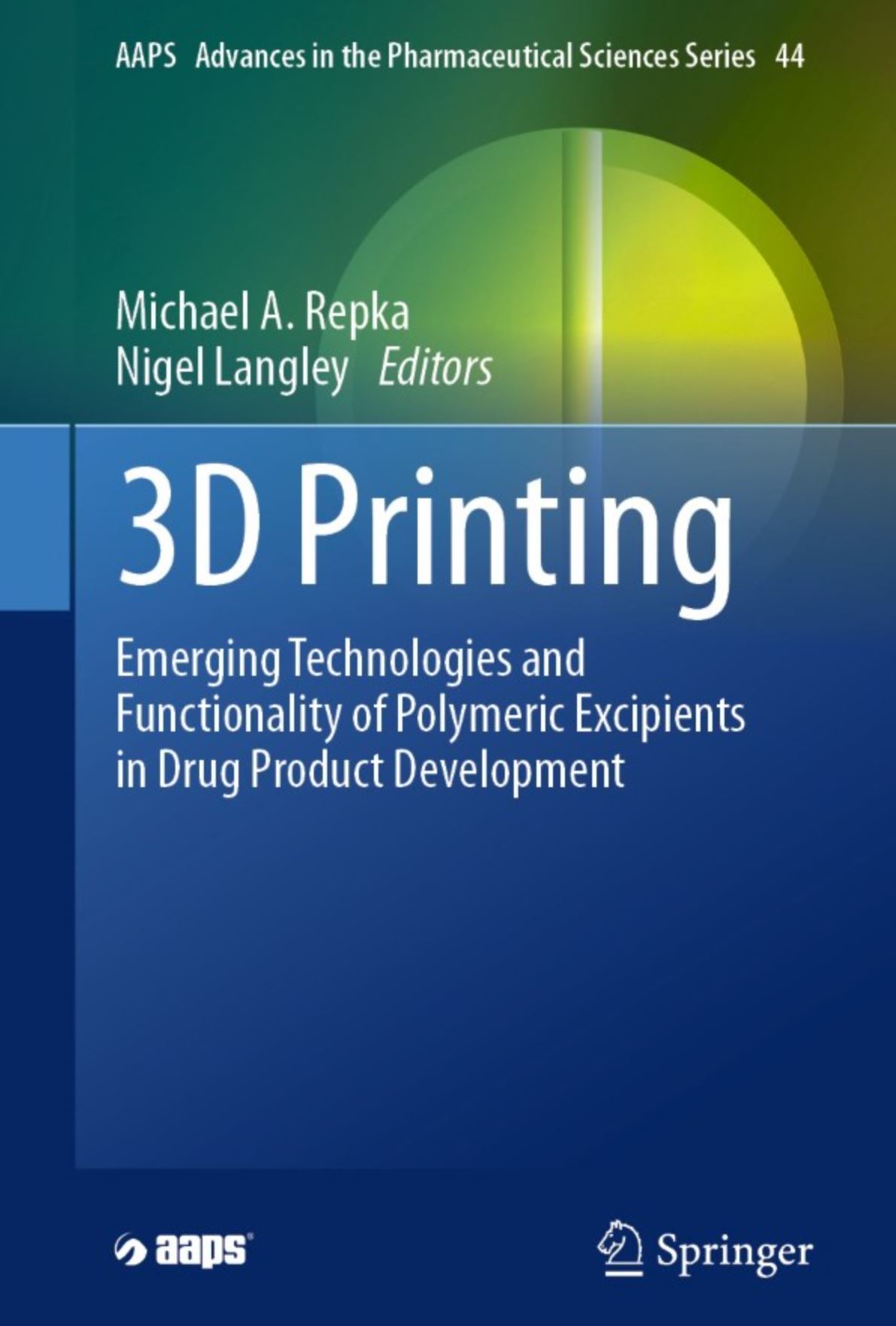3D Printing Emerging Technologies and Functionality of Polymeric Excipients in Drug Product Development – Part 3

See the new book, edited by Michael A. Repka, Nigel Langley
- Covers regulatory and manufacturing aspects of 3D printing in drug development
- Particular focus on hot melt extrusion and extruded filaments suitable for optimizing 3D printing
- Thorough short text and guide for use on the production line of 3D printing of pharmaceuticals
Description:
This inclusive text describes 3D Printing for pharmaceutical applications, including emerging 3D technologies. The book focuses on the functionality of the materials/biomaterials used for the preparation of dosage forms and devices, fundamentals for preparing these systems and novel applications using these additive manufacturing techniques. Also, the text includes clinical relevance and regulatory considerations for the future of personalized medicine.
Authored by experts with a broad range of experience, extensive insight into the science of 3D printing technology used to produce these systems is provided. Highlighting viewpoints from the academic, polymer excipient, equipment, product development and regulatory communities, this comprehensive text compiles input from industry thought leaders to illustrate strategies and technologies for applying techniques of additive manufacturing for drug product and device development while also providing insight into the path forward for the technology in years to come.
Chapter 7
Hot-Melt Extrusion Paired Fused Deposition Modeling 3D Printing: Development of Pharmaceutical Medications
In recent years much research has been conducted exploring the suitability of various additive manufacturing (AM) techniques for developing pharmaceuticals. In 2015 the approval of the first 3D-printed product SPRITRAM® (levetiracetam) by the US Food and Drug Administration (USFDA) attracted researchers from various avenues of the pharmaceutical sector. The orally disintegrating levetiracetam tablets are manufactured by Aprecia Pharmaceuticals (Ohio, USA) utilizing a novel zip dose technology platform. Developing pharmaceuticals by AM process allows physicians to control the dose of the medications rather than prescribing the dose determined by pharmaceutical industries. Depending on age, sex, race, state of disease, and biological factors, a single dose of medication might not be suitable for the entire patient population. The AM techniques enable the fabrication of on-demand medications for different doses and geometries. In addition, AM also provides the flexibility of controlling the release profiles by adjusting the infill densities of the medications. Complex medications such as polypills can also be fabricated, making it easier for geriatric patients experiencing dysphagia. The AM has various advantages when compared with conventional manufacturing techniques. This chapter mainly focuses on the fused deposition modeling (FDM) 3D printing technique along with the hot-melt extrusion (HME) platform, which is needed for developing the feedstock (drug-loaded polymeric filaments) material. Various critical parameters concerning the process, formulation, and instrument are discussed in detail, with a small note on the advantages and limitations.
Nyavanandi, D., Narala, S., Repka, M.A. (2024). Hot-Melt Extrusion Paired Fused Deposition Modeling 3D Printing: Development of Pharmaceutical Medications. In: Repka, M.A., Langley, N. (eds) 3D Printing . AAPS Advances in the Pharmaceutical Sciences Series, vol 44. Springer, Cham. https://doi.org/10.1007/978-3-031-46015-9_7
Chapter 9
Free-D Molding: Every Idea Deserves a Prototype
3D printing is changing the world. However, the progress for pharmaceutical applications is slower than in other industries. It comes with unique challenges previously only solvable with significant resources. Materials are considerably more expensive, and the properties are mostly unknown. Often innovators did not have the tools to turn their ideas into reality under those restrictions.
Novel free-D molding explores freely shaped dosage form ideas with minimum material knowledge and material requirement. It is based on vacuum compression molding and uses nonstick mold materials to allow quick formulation development with temperature and time as the only two required processing parameters. Thus, single researchers can work on prototypes of complex 3D geometries out of new formulations, which previously required large teams and budgets.
Bramböck, A., Treffer, D. (2024). Free-D Molding: Every Idea Deserves a Prototype. In: Repka, M.A., Langley, N. (eds) 3D Printing . AAPS Advances in the Pharmaceutical Sciences Series, vol 44. Springer, Cham. https://doi.org/10.1007/978-3-031-46015-9_9
See the full book here:
Michael A. Repka, Nigel Langley, 3D Printing Emerging Technologies and Functionality of Polymeric Excipients in Drug Product Development, https://doi.org/10.1007/978-3-031-46015-9, ISBN 978-3-031-46017-3Due: 16 December 2024

